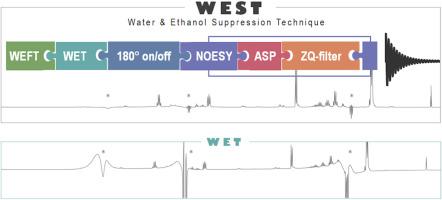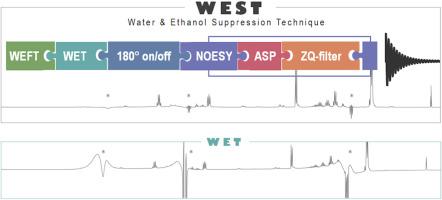WEST: an “all-terrain” multiple signal suppression technique for quantitative 1H NMR
IF 6
2区 化学
Q1 CHEMISTRY, ANALYTICAL
引用次数: 0
Abstract
Background
Quantitative NMR analysis of complex samples may involve the suppression of multiple signals. The WET (Water suppression Enhanced through T1 effects) sequence is currently used, but it is known to be less efficient when using high field spectrometers and/or cryoprobes. Saturation based methods have been proposed to circumvent this problem. However, these approaches require a very precise adjustment of the saturated frequencies on each sample and does not allow the suppression of satellite peaks or require specific hardware configuration. A new approach, called WEST, is presented in order to address all these issues.
Results
The proposed strategy has been performed using three spectrometers from two different manufacturers, with two different magnetic field strengths and three different probe configurations. This has shown that the WEST approach has been effective in a wide range of difficult conditions. The water frequency was measured using a standard proton acquisition and used as offset for the WEST spectrum. This was the only frequency adjustment needed, requiring only 5 s to perform. A good repeatability was demonstrated and suppression efficiency was maintained, even with a 5 Hz shift and 1 dB RF power deviation. Like the WET sequence it is based on, WEST suppresses an arbitrary number of signals and allows the suppression of satellite peaks. In addition, compared to the WET sequence, WEST was able to reduce the solvent by at least 93 %, thereby reducing the residual signal and so allowing a bigger dynamic of the receiver to analyze the compounds of interest.
Significance
Therefore, the WEST sequence is robust, requires minimal adjustments, and thus can be an efficient tool for high-throughput 1H NMR whatever the spectrometer used. Most of this work has been carried out on whisky samples, but the method has a much wider field of application, such as LC-NMR studies or matrix signal suppression to increase the signal intensity of minor components.


WEST:用于定量1H NMR的“全地形”多重信号抑制技术
复杂样品的定量核磁共振分析可能涉及到多个信号的抑制。目前使用的是WET(通过T1效应增强的水抑制)序列,但已知在使用高场光谱仪和/或低温探针时效率较低。已经提出了基于饱和的方法来规避这个问题。然而,这些方法需要对每个样本的饱和频率进行非常精确的调整,并且不允许抑制卫星峰值或需要特定的硬件配置。为了解决所有这些问题,提出了一种名为WEST的新方法。结果采用两家不同制造商的三台光谱仪,采用两种不同的磁场强度和三种不同的探针配置,执行了所提出的策略。这表明西方的方法在各种各样的困难条件下都是有效的。水的频率是用一个标准的质子采集来测量的,并用作西光谱的偏移。这是唯一需要的频率调整,只需要5秒来执行。即使在5 Hz频移和1 dB射频功率偏差的情况下,也能保持良好的重复性和抑制效率。就像它所基于的WET序列一样,WEST抑制任意数量的信号,并允许抑制卫星峰值。此外,与WET序列相比,WEST能够减少至少93%的溶剂,从而减少残留信号,从而允许接收器更大的动态分析感兴趣的化合物。因此,WEST序列是稳健的,需要最小的调整,因此可以成为高通量1H-NMR的有效工具,无论使用何种光谱仪。这项工作大部分是在威士忌样品上进行的,但该方法有更广泛的应用领域,例如LC-NMR研究或矩阵信号抑制以增加次要成分的信号强度。
本文章由计算机程序翻译,如有差异,请以英文原文为准。
求助全文
约1分钟内获得全文
求助全文
来源期刊

Analytica Chimica Acta
化学-分析化学
CiteScore
10.40
自引率
6.50%
发文量
1081
审稿时长
38 days
期刊介绍:
Analytica Chimica Acta has an open access mirror journal Analytica Chimica Acta: X, sharing the same aims and scope, editorial team, submission system and rigorous peer review.
Analytica Chimica Acta provides a forum for the rapid publication of original research, and critical, comprehensive reviews dealing with all aspects of fundamental and applied modern analytical chemistry. The journal welcomes the submission of research papers which report studies concerning the development of new and significant analytical methodologies. In determining the suitability of submitted articles for publication, particular scrutiny will be placed on the degree of novelty and impact of the research and the extent to which it adds to the existing body of knowledge in analytical chemistry.
 求助内容:
求助内容: 应助结果提醒方式:
应助结果提醒方式:


